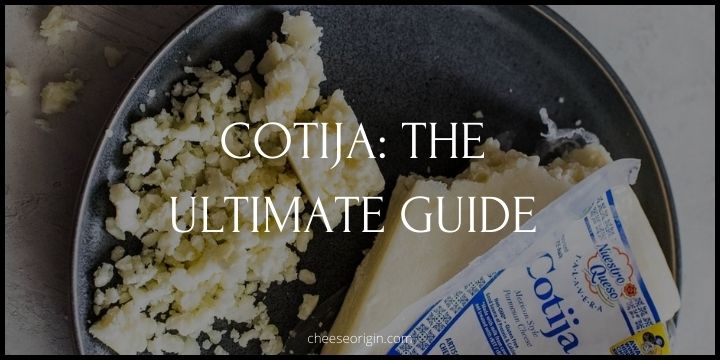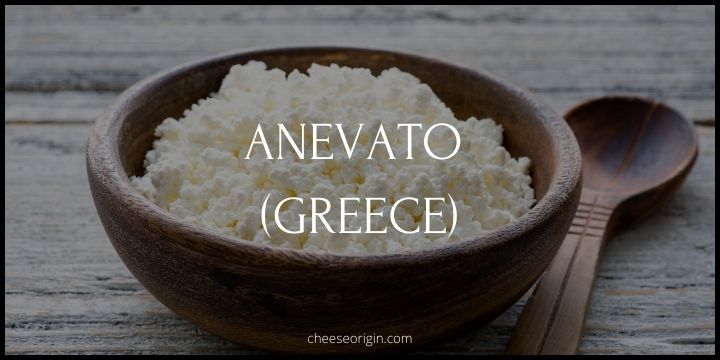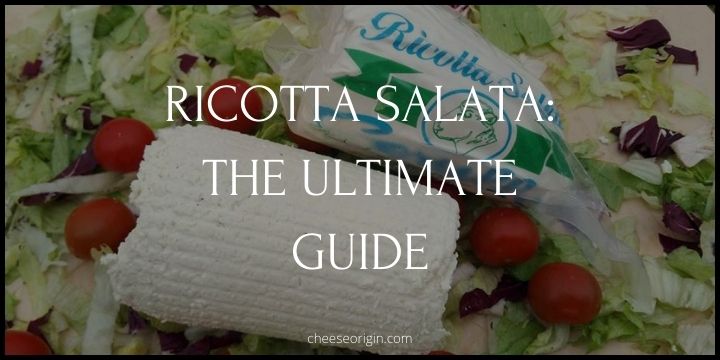What is Kasseri Cheese? The Greek-Turkish Delight You Need to Try
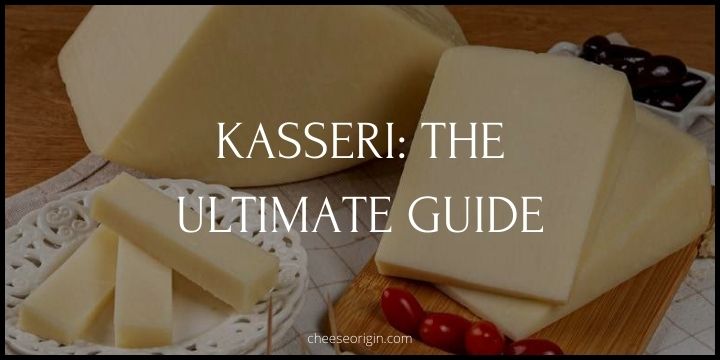
Today, we’ll delve into the fascinating journey of Kasseri, from its humble origins in the picturesque regions of Thessaly and Macedonia, to its unique production process, and its versatility in a variety of dishes.
Prepare to embark on a delicious exploration that will tantalize your taste buds and deepen your appreciation of Greek cuisine.
Welcome to the world of Kasseri!
Quick Facts About Kasseri
| Kasseri Cheese Quick Facts | Description |
|---|---|
| Origin | Greece |
| Milk Source | Sheep’s milk, often mixed with up to 20% goat’s milk |
| Texture | Semi-hard, elastic |
| Flavor | Mildly salty with a hint of olive oil |
| Color | Pale yellow |
| Aging Process | At least four months |
| Uses | Ideal for grilling, in sandwiches, or as a table cheese |
| Production Process | The curd is heated, stretched, molded, and then aged |
What type of cheese is Kasseri?
Kasseri is a medium-hard cheese variety that originates from Greece. It is traditionally made from a blend of sheep’s and goat’s milk, although commercial versions may also include cow’s milk. The ratio of sheep to goat milk can vary, but typically, the percentage of goat milk does not exceed 20%.
The production process of Kasseri involves heating the curd to a high temperature and kneading it before shaping and salting. This cheese is aged for at least four months, which gives it a pale yellow color, a slightly tangy flavor, and an elastic texture.
Kasseri is often used in traditional Greek dishes. It’s an excellent choice for saganaki, a popular Greek appetizer where the cheese is pan-fried until it’s bubbling and golden brown. But it’s also versatile enough to be used in sandwiches, salads, or simply served with fruit as part of a cheese platter.
Although Kasseri is widely enjoyed in Greece, it has also gained popularity in other parts of the world due to its unique taste and texture.
Kasseri tasting notes
- Appearance: Kasseri cheese is a semi-hard pale yellow cheese. It’s typically sold in wheels or blocks and has a smooth and shiny rind.
- Texture: When fresh, Kasseri has a compact, slightly elastic texture. As it ages, it becomes harder and less elastic. When melted, it becomes stretchy and stringy, maintaining a chewy texture.
- Smell: Kasseri has a mild, pleasant aroma with hints of buttery sheep’s milk. There’s no strong or pungent odor, making it quite approachable.
- Taste: The flavor of Kasseri is mild but distinctive, often described as tangy or slightly tart. It has a subtle nutty note and a faint sweetness that comes from the sheep’s milk.
- Aftertaste: The finish is clean and slightly salty, with a lingering tanginess.
- Pairing: Kasseri pairs well with fruits like apples and pears, as well as olives, nuts, and honey. It’s excellent when served with robust red wines or crisp white wines. It can also be paired with beers that have a strong, hoppy flavor.
- Cooking: Due to its melting properties, Kasseri is often used in cooking. It’s popular in dishes like saganaki, where the cheese is fried until melty and golden, or in pies and sandwiches. It can also be grilled or used in a fondue.
What is Kasseri cheese similar to? 7 good substitutes
| Substitute | Description |
|---|---|
| Mozzarella | Mozzarella is a good substitute because of its similar spongy flavor and texture. Although it’s not made from sheep or goat milk like Kasseri, it can still be used in a variety of dishes. |
| Caciocavallo | Caciocavallo cheese is a great alternative because it has a similar texture and slightly tangy flavor to Kasseri. It’s an Italian cheese that’s also made from cow’s milk. |
| Provolone | Provolone cheese can be a great substitute for Kasseri cheese, as it has a similar smooth texture and flavor profile. It’s slightly stronger in flavor but melts well, making it a good choice for cooking. |
| Pecorino Romano | Pecorino Romano is a good substitute due to its similar salty and tangy flavor. This Italian cheese is made from sheep’s milk, making it closer to the original composition of Kasseri. |
| Kefalotyri | Kefalotyri, another Greek cheese, is a good substitute because it’s also made from sheep’s and goat’s milk. It’s a bit harder and saltier than Kasseri but works well in cooked dishes. |
| Asiago | Asiago is a versatile Italian cheese with a flavor that can range from mild when it’s fresh, to sharp when it’s aged. It can work as a substitute for Kasseri in many recipes. |
| Colby | Colby is an American semi-hard cheese with a mild flavor. It’s less creamy than Kasseri, but its similar texture makes it a good alternative for melting or in sandwiches. |
Is Kasseri like Halloumi?
While both Kasseri and Halloumi are Mediterranean cheeses, they have distinct characteristics that set them apart.
| Attribute | Kasseri | Halloumi |
|---|---|---|
| Origin | Greece | Cyprus |
| Milk Used | Traditionally made from a blend of sheep’s and goat’s milk. | Typically made from a mixture of goat’s and sheep’s milk, sometimes with added cow’s milk. |
| Texture | Medium-hard, elastic | Semi-hard, rubbery |
| Flavor | Slightly tangy | Salty, slightly creamy |
| Melting Point | Melts when heated | High melting point, retains shape when grilled or fried |
| Common Uses | Used in traditional Greek dishes, melted in sandwiches, salads, or served with fruit as part of a cheese platter | Popularly grilled or fried due to its high melting point, used in salads, sandwiches, or served with watermelon |
Halloumi:
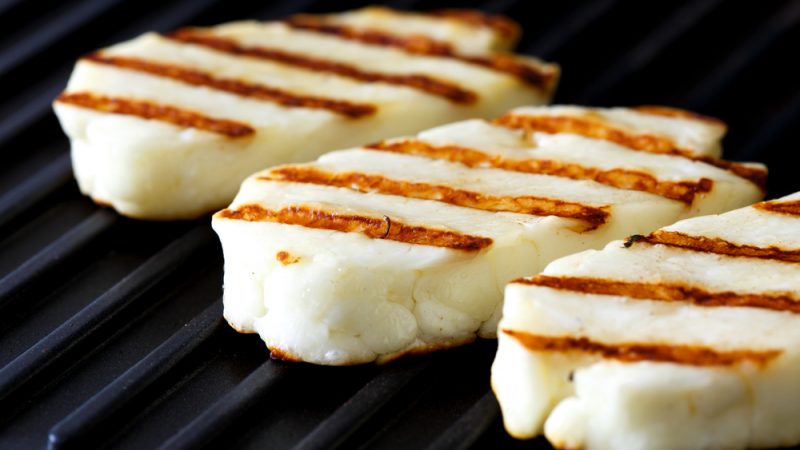
Halloumi is a semi-hard, unripened, brined cheese from Cyprus. It’s typically made from a mixture of goat’s and sheep’s milk, sometimes with added cow’s milk. What sets halloumi apart is its high melting point, which allows it to retain its shape when grilled or fried, making it a popular choice for these cooking methods.
>> Click here to read our in-depth guide on Halloumi
Kasseri:
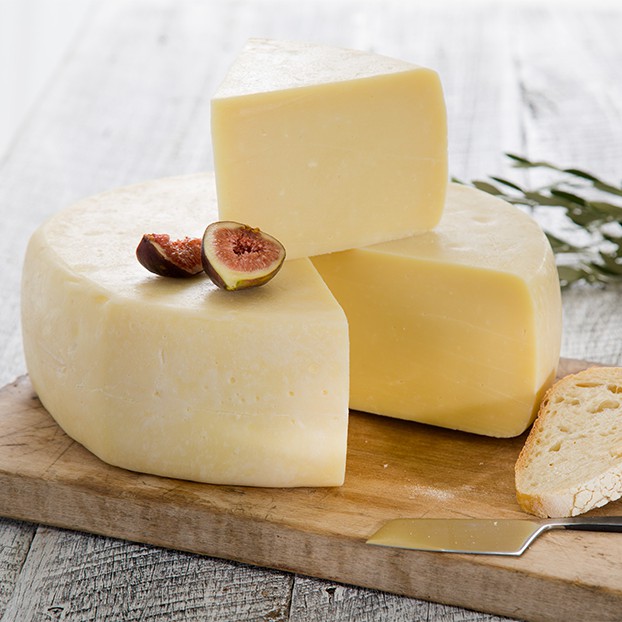
On the other hand, Kasseri is a medium-hard cheese from Greece that’s traditionally made from a blend of sheep’s and goat’s milk. It has a slightly tangy flavor and an elastic texture. Unlike halloumi, Kasseri will melt when heated, which makes it an excellent choice for dishes where melted cheese is desired, such as in a pizza or sandwich.
Is Kasseri similar to Feta?
Kasseri and Feta are both traditional Greek cheeses, but they have distinctive characteristics:
| Attribute | Kasseri | Feta |
|---|---|---|
| Origin | Greece | Greece |
| Milk Used | Traditionally made from a blend of sheep’s and goat’s milk. | Made from sheep’s milk or a blend of sheep’s and goat’s milk. |
| Texture | Medium-hard, elastic when fresh, becomes harder with age | Soft and crumbly |
| Flavor | Mild, slightly tangy, becomes more pungent with age | Tangy, salty |
| Color | Pale yellow | White |
| Storage | Not stored in brine | Stored in brine |
| Melting Point | Melts when heated | Doesn’t melt easily |
| Common Uses | Used in traditional Greek dishes, melted in sandwiches, salads, or served with fruit as part of a cheese platter | Used in salads, pastries, or as a table cheese |
Feta:
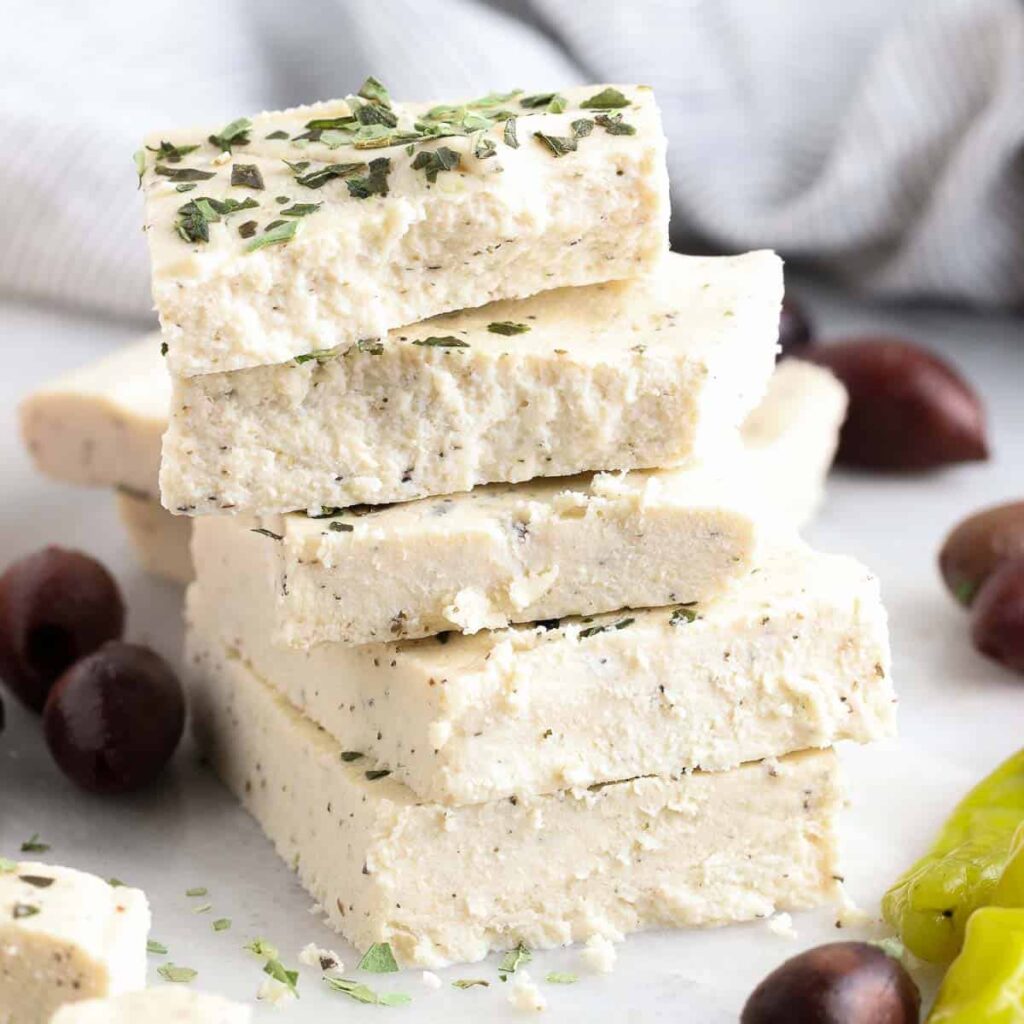
Feta is a white, crumbly cheese that’s made from either sheep’s milk or a blend of sheep’s and goat’s milk. It’s stored in brine, which gives it a tangy, salty flavor and a slightly creamy texture. Feta is often used in salads, pastries, or as a table cheese.
Kasseri:
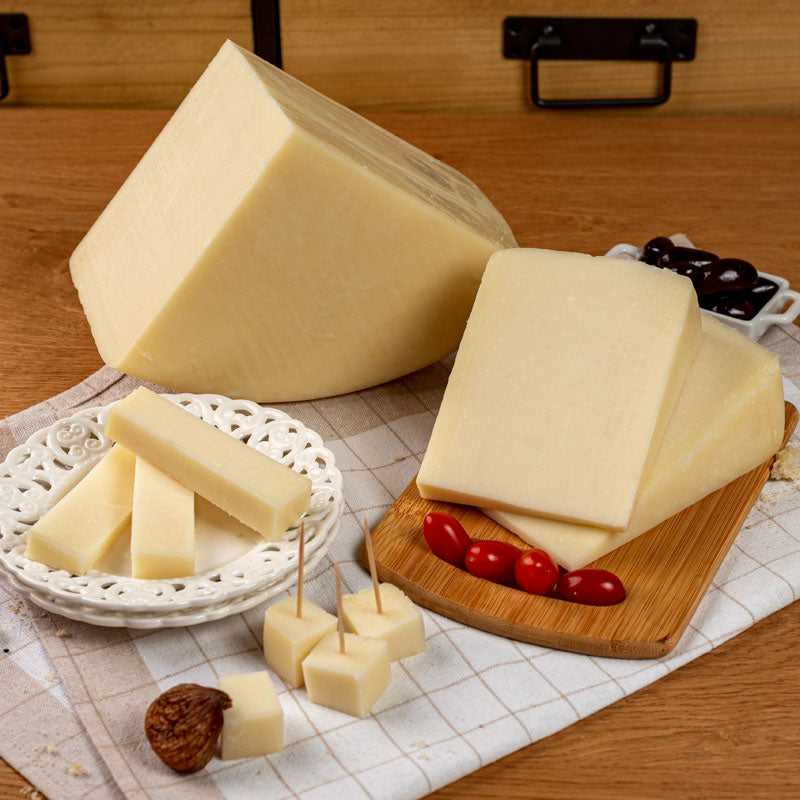
Kasseri is a medium-hard, pale yellow cheese traditionally made from a mix of sheep’s and goat’s milk. It has a mild, slightly tangy flavor and an elastic texture when fresh, becoming harder and more pungent with age. Unlike feta, Kasseri can be melted, making it suitable for dishes like pizza, pasta, or grilled cheese sandwiches.
>> Click here to read our in-depth guide on Feta
How is Kasseri cheese made?
Kasseri cheese is traditionally made using a blend of sheep’s and goat’s milk. The process is somewhat similar to other cheese-making methods but with specific steps unique to Kasseri.
- Milk Collection: The process begins with collecting fresh milk, typically a blend of sheep’s and goat’s milk.
- Pasteurization: The milk is then pasteurized to kill any harmful bacteria and ensure the cheese is safe for consumption.
- Curdling: Rennet, an enzyme that causes milk to curdle, is added to the pasteurized milk. The milk is allowed to sit until it forms curds and whey.
- Cutting and Cooking the Curd: The curds are cut into small pieces to expel more whey, then gently heated.
- Draining and Pressing: The curds are drained to remove the whey and then pressed to form a firm, elastic texture.
- Salting and Aging: The cheese is salted to enhance the flavor and help preserve it. It’s then aged for at least four months to develop its characteristic flavor and texture.
Is Kasseri healthy?
Health Benefits:
- Protein: Kasseri is a good source of protein, which is essential for building and repairing tissues in your body.
- Calcium: Cheese is typically high in calcium, which is important for bone health.
- Vitamins and Minerals: Kasseri also contains other vitamins and minerals like vitamin A, vitamin B12, zinc, and phosphorus.
Considerations:
- Fat and Calories: Kasseri, like many cheeses, can be high in saturated fat and calories. Consuming too much can contribute to weight gain and other health problems.
- Sodium: Cheese, particularly if it’s aged or processed, can be high in sodium. Too much sodium can contribute to high blood pressure and other health issues.
- Lactose: People with lactose intolerance may have trouble digesting Kasseri and other dairy products.
While Kasseri has several nutritional benefits, it should be eaten in moderation as part of a balanced diet.
Also read: Savor the Flavor: 20 Cheeses with the Least Lactose
Kasseri nutrition facts
| Nutrient | Amount (Per 1 oz Serving) |
|---|---|
| Calories | 90 – 110 |
| Calories from Fat | Approximately 73.6% |
| Total Fat | 8g |
| Saturated Fat | 21g |
| Sodium | 280mg – 1000mg |
| Total Carbohydrates | 0g |
| Dietary Fiber | 0g |
| Sugars | 0g |
| Protein | 8g |
What goes well with Kasseri? Pairing guide
Food that goes well with Kasseri
| Category | Food |
|---|---|
| Meat | Lamb (as in “Surprise” Lamb, Country Style and Lamb Burgers) |
| Vegetables | Asparagus (in Asparagus Tip Pasta), Zucchini and Yellow Squash (in Grilled Summer Squash and Kasseri Cheese with Lemon and Mint) |
| Pasta | Asparagus Tip Pasta |
| Appetizers | Saganaki (Flaming Greek Cheese) |
| Breakfast | Breakfast Poutine with Kasseri Cheese and Fresh Herbs |
Also read: 11 Best Crackers that Pair Well with Cheese
Beverage that goes well with Kasseri
| Category | Beverage |
|---|---|
| Red Wine | Spicy red wine, Cabernet Sauvignon, Xinomavro, Zinfandel |
| White Wine | Pinot Blanc |
| Sweet Wine | Malagousia |
Also read: Best Wine and Cheese Pairings: The Ultimate Guide
Frequently Asked Questions
1. What is Kasseri cheese in English?
“Kasseri” is actually an English transliteration of the Greek name for this particular type of cheese. It’s a medium-hard pale yellow cheese made from unpasteurized sheep milk with no more than 20% goat’s milk mixed in
It’s a traditional Greek cheese, and the name “Kasseri” is protected under EU law, meaning that only cheese produced in certain regions of Greece using specific methods can be called Kasseri.
2. What country is Kasseri cheese from?
Kasseri cheese originates from Greece. It’s a traditional Greek-Turkish cheese that is particularly associated with the Greek provinces of Thessaly, Macedonia, Lesbos, and Xanthi.
The term “Kasseri” is thought to potentially come from either the Latin word ‘caseus’ (meaning cheese), or the Hebrew word ‘kosher’. However, it should be noted that Kasseri cheese itself is not related to the concept of Kosher foods in Jewish dietary laws.
3. What is the texture of Kasseri cheese?
Kasseri cheese is a semi-hard cheese with a smooth texture. When fresh, it has a compact, homogeneous texture that’s slightly elastic. As Kasseri cheese ages, it becomes harder and less elastic.
The cheese is known for its unique characteristic of becoming stretchy when heated, making it an excellent choice for melting.
When melted, it maintains a chewy, stringy texture which is why it’s commonly used in dishes like saganaki (a Greek dish where the cheese is fried until melty and golden) or in pies and sandwiches.
4. Can I freeze Kasseri cheese?
Yes, you can freeze Kasseri cheese, but it’s important to note that freezing can slightly alter the texture and flavor of the cheese. The process of freezing can cause the cheese to become more crumbly and less creamy when thawed.
Here’s a simple guide on how to freeze Kasseri cheese:
- Cut the cheese into small portions. This will make it easier to thaw only what you need at a time.
- Wrap each portion tightly in plastic wrap or aluminum foil to prevent freezer burn.
- Place the wrapped cheese in a freezer bag. Squeeze out as much air as possible before sealing the bag.
- Label the bag with the date so you can keep track of how long it’s been in the freezer.
- When you’re ready to use the cheese, thaw it in the refrigerator. This slow thawing process will help maintain its texture and flavor as much as possible.
Even though you can freeze Kasseri cheese, it’s usually best to enjoy it fresh to appreciate its full flavor and texture.
Also read: What’s the Best Way to Store Cheese?
5. Is Kasseri cheese lactose-free?
Kasseri cheese is not lactose-free. It’s made from fresh and unpasteurized milk which contains lactose. Therefore, it may not be suitable for individuals with lactose intolerance or a milk allergy. However, everyone’s tolerance to lactose varies, so some people might find they can consume small amounts without issue.
Also read:
- Discovering Panela: A Guide to Mexico’s Versatile Cheese
- All About Swiss Cheese: A Comprehensive Guide
- The Tale of Taleggio: Unveiling Italy’s Pungent Treasure
- Cotswold Cheese: A Taste of England’s Finest
- The Ultimate Guide to Hoop Cheese: A Southern Delight
- The Ultimate Guide to Chèvre: Exploring Goat Cheese
- Fior di Latte: A Comprehensive Guide to Italy’s Creamy Delight



